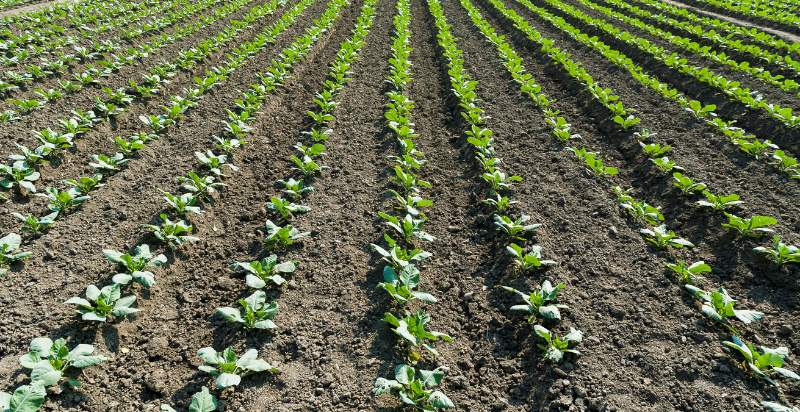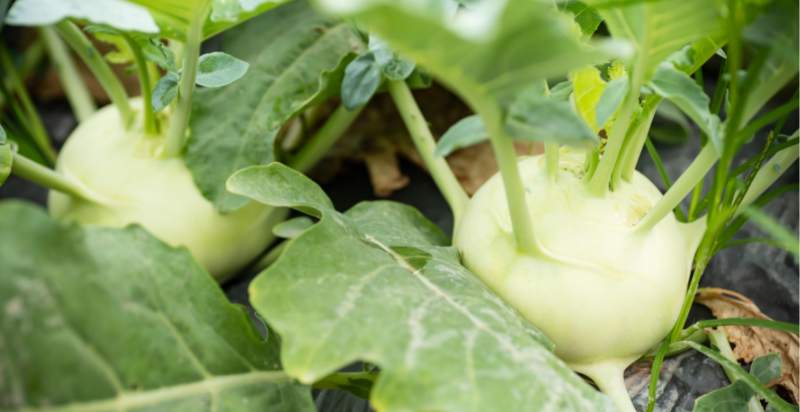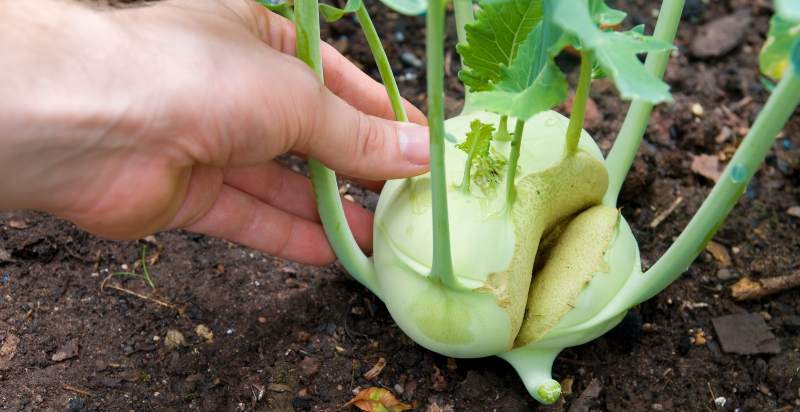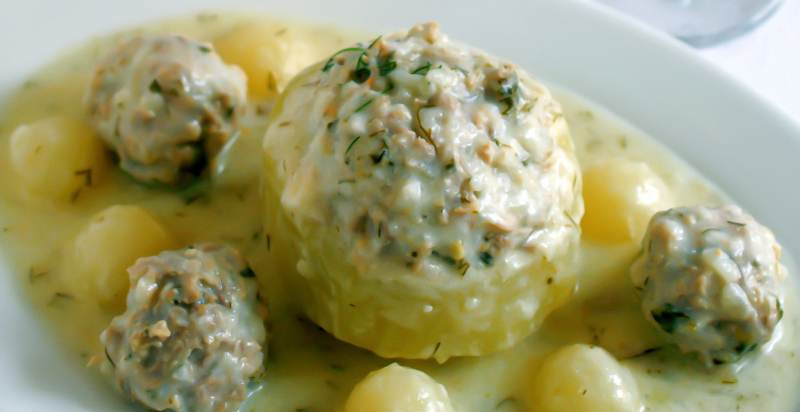Kohlrabi is a versatile and nutritious vegetable that looks like an alien. It has a unique shape, a knobby bulbous top, and long stems with green leaves sprouting. Kohlrabi belongs to the Brassica family, which includes cabbage, broccoli, cauliflower, Brussels sprouts, and kale; all these vegetables are known for their health benefits.
This vegetable is increasingly becoming popular because it’s easy to prepare, and its mild, slightly sweet flavor pairs well with many different dishes. Here is everything you wanted to know about :
What is Kohlrabi?
Kohlrabi is a bulb-like edible vegetable that belongs to the Brassica family. It has a sweet and mild flavor, resembling cabbage but with a hint of sweetness. Its leaves are edible, too, although they have a slightly bitter taste. Kohlrabi can be eaten raw or cooked in many different ways – boiled, steamed, roasted, grilled, or stir-fried. It is high in dietary fiber and contains vitamins and minerals like potassium, vitamin C, folate, magnesium, and phosphorus.
History and Origin of Kohlrabi:
Kohlrabi has its roots in Central Europe and is believed to have been cultivated by the ancient Romans. It is a hybrid of turnip and cabbage, first developed in Germany hundreds of years ago. The name “kohlrabi” comes from the German words “kohl,” meaning cabbage, and “rabi,” meaning turnip. Today, kohlrabi is widely grown in many countries across Europe and Asia.
Types of Kohlrabi:
There are two main types of kohlrabi – the purple variety and the white variety. The purple one is sweeter, while the white one is slightly more bitter. Both are high in dietary fiber, vitamins, and minerals. They can be eaten raw or cooked, either roasted or boiled.

Nutritional Value of Kohlrabi:
Kohlrabi is a low-calorie, nutrient-dense vegetable. It contains vitamins A, C, E, and K, as well as a variety of B vitamins like thiamine and riboflavin. In addition to its antioxidant content, kohlrabi is a good source of dietary fiber, iron, and phosphorus.
Health Benefits of Kohlrabi:
Kohlrabi is a great source of dietary fiber, which helps keep you full and can aid digestion. Its high vitamin and mineral content makes it a good source of antioxidants, which can support heart health and help fight off illnesses. Additionally, kohlrabi is low in calories, so it is an excellent choice for those looking to maintain or lose weight.

How to Plant Kohlrabi?
Kohlrabi is a delicious, easy-to-grow vegetable that can be added to many dishes. It features an edible bulbous stem that becomes sweeter as it matures and has been described as having a pleasant taste resembling broccoli stems.
This cool-weather crop grows best in climates with short growing seasons of around 60-80 days, meaning it can be planted in the early spring or late fall when other vegetables are no longer producing. If you’re looking for a unique addition to your garden this year, here’s how to plant kohlrabi.
Step 1: Choose Your Spot
Before planting your kohlrabi seeds or plants, choose a spot in your garden with full sun exposure and well-draining soil. Kohlrabi is forgiving of different soil types but needs consistent moisture to thrive. If you plan on planting multiple rows of kohlrabi, space them at least 18 inches apart for proper air circulation.
Step 2: Prepare the Soil
Kohlrabi does best in nutrient-rich soil with a pH range between 6 and 7. To give your kohlrabi the best start possible, begin by tilling or turning the soil 10 to 12 inches deep. Once your soil is turned over, mix in a generous layer of compost or aged manure to help improve drainage and add vital nutrients to the area.
Step 3: Plant Your Seeds
Once you’ve properly prepared your soil, it’s time to plant the kohlrabi seeds. Plant them directly in the ground or sow them in seed trays and then transplant them later. In either case, space the seeds approximately 2-3 inches apart and cover them with 1/4 inch of soil. Water thoroughly after planting and keep the area moist until germination occurs, usually within 7-10 days.
Step 4: Provide Proper Care
Kohlrabi requires consistent moisture throughout its growth cycle to reach full maturity. Make sure you water your plants at least once a week during dry spells or use a drip irrigation system. Apply mulch around your plants to help retain moisture and keep weeds at bay.

Step 5: Harvest Time!
When the kohlrabi stem reaches a diameter of two to three inches, it is ready for harvesting. Use a sharp knife or garden trowel to cut the stem away from the plant; be sure not to damage any other remaining plants in the process. Enjoy your harvest fresh, or store it in a cool place until you’re ready to use it.
With these steps, you’ll have no trouble growing delicious kohlrabi in your backyard. Planting kohlrabi can give you an exciting new addition to your vegetable dishes and make this spring season special.

How To Care For Kohlrabi?
Once your kohlrabi plants are in the ground and thriving, you’ll need to focus on providing them with proper care. Below are a few tips for helping your kohlrabi reach its full potential:
- Fertilize regularly – Feed your kohlrabi every four weeks with organic fertilizer or compost tea to help ensure maximum productivity.
- Weed often- Pull any weeds that pop up around your kohlrabi plants as soon as possible to reduce competition for nutrients and light.
- Monitor pests – Check your plants frequently so that you can spot any pests before they cause too much damage. If needed, use insecticidal soap to combat common garden pests.
- Thin plants – Once your kohlrabi seedlings have grown to about 2 inches in height, thin them out by pinching off any extra seedlings. Keep only the strongest and healthiest plants for maximum productivity.
By following these simple steps, you’ll be able to enjoy a successful harvest of delicious kohlrabi this season! Try planting some today and see what tasty dishes you can create.
Additional Things To Know About Kohlrabi:
Here are some points that you must know about Kohlrabi:
Where to Plant Kohlrabi
Kohlrabi does best in full sun and well-drained soil with plenty of organic matter. Before planting, work some compost or aged manure into the soil to ensure good drainage and fertility. You can plant seeds directly into the garden, where they receive at least 6 hours of direct sunlight daily. If you live in an area with shorter days, supplement it with artificial light.
When to Plant Kohlrabi
Kohlrabi is a cool-season vegetable, so it should be planted in early spring before the soil gets too warm. You can plant kohlrabi again in late summer in mild climates for fall harvest. Check the last frost date in your area and wait until after that date to plant seeds outdoors.
Climate Requirements
Kohlrabi prefers full sun and can tolerate various soil types, including clay, loam, and sandy soils. It is also tolerant to some drought-like conditions. However, it will grow best when the soil temperature is between 60° F (15° C) and 75° F (24° C).
Preventions from Pests and Diseases:
Kohlrabi is susceptible to several pests and diseases, but they can be managed properly. To prevent them from infesting your plants, make sure that you:
- Provide adequate spacing between plants – Crowded conditions promote the spread of disease and increase pest activity.
- Remove any old or diseased plant debris – Disease-causing organisms can remain in the soil for months, so it’s important to clean up after harvesting to reduce the risk of infection.
- Monitor regularly– Inspect your kohlrabi plants frequently so that you can spot any pest or disease problems early on. If needed, treat affected areas with an organic insecticide or fungicide as soon as possible.
- Use crop rotation – Planting kohlrabi in the same area each year can lead to a buildup of disease and pest problems. Crop rotation helps to break up this cycle and reduce risks.
By taking these preventive measures, you’ll be able to keep your kohlrabi plants healthy and productive for the entire growing season.
How to Harvest Kohlrabi?
Your kohlrabi is ready to harvest when the stem reaches a diameter of 2-3 inches. Cut the stem away from the plant with a sharp knife or garden trowel for best results without damaging any other plants. Once you’ve harvested your kohlrabi, enjoy it fresh or store it in a cool location until you’re ready to use it.
If left on the plant for too long, kohlrabi will become tough and woody, making it difficult to enjoy. So make sure that you keep an eye on your plants so that you can harvest them at their peak!
Congratulations! You are now well on your way to growing delicious kohlrabi in your garden. With these tips, you’ll be able to enjoy a successful and bountiful harvest this season. So get out there and start planting!

How to Store Homegrown Kohlrabi?
To keep your kohlrabi fresh and tasty for as long as possible, it’s important to store it properly. Below are a few tips for storing homegrown kohlrabi:
- Remove the leaves – Kohlrabi leaves will quickly go bad if left on the plant, so make sure to remove them before storing them.
- Trim the stems – Cut off any excess stem material with a sharp knife or garden shears before storage to reduce spoilage.
- Store in a cool area – Place your harvested kohlrabi in a bag or container and store it in a refrigerator or cool place until ready to use.
Following these steps, you can keep your homegrown kohlrabi fresh and flavorful for weeks! Enjoy the fruits of your labor this season with delicious dishes made from freshly-harvested kohlrabi.
How to Use Kohlrabi?
Kohlrabi is a versatile vegetable that can be used in many different recipes. Here are some ideas for using kohlrabi in your cooking:
- Slice it and eat it raw – Kohlrabi has a mild, sweet flavor that makes it ideal for eating fresh. Slice the bulb into thin strips and enjoy it as a snack or salad topping.
- Roast it – Cut the bulb into cubes, toss with oil and spices, then bake until tender. Serve as a delicious side dish alongside your main course.
- Steam or saute it – Peel and cube the bulb, then simmer in water or olive oil until cooked. Top with butter, salt, pepper, or a flavorful sauce to enjoy.
- Make it into a soup – Simmer diced kohlrabi in vegetable stock for about 15 minutes, then blend until smooth. Add cream and seasonings of your choice for a comforting, filling meal.
By using kohlrabi in these delicious recipes, you’ll enjoy this unique vegetable’s sweet flavor all season long!

Potential Risks From Kohlrabi:
Although kohlrabi is generally considered a very healthy food, there are a few potential risks. For example, kohlrabi contains oxalates, which can interfere with the absorption of certain minerals. In addition, kohlrabi may trigger an allergic reaction in some individuals due to its high sulfur content.
To reduce these risks and safely enjoy the benefits of kohlrabi, it’s important to speak with your doctor before adding this vegetable to your diet.
With these tips in mind, you’ll be able to make informed decisions about how to grow and use kohlrabi for maximum nutrition and flavor. So get out there and start harvesting delicious kohlrabi today!
You can enjoy a successful and satisfying crop of kohlrabi by following these instructions. With its mild flavor and crunchy texture, this nutritious vegetable will surely become a favorite in your home garden.
Conclusion:
Now that you know how to plant, care for, and harvest kohlrabi, why not give it a try? Not only is it easy to grow, but its sweet flavor makes it perfect for adding to all dishes. Give this unique vegetable a chance – you won’t regret it! And don’t forget to have fun while gardening; that’s part of what makes the experience so special. Happy planting!
Growing kohlrabi is a rewarding experience, so I hope you enjoy the process and the delicious result. Have fun! 🙂
- Everything You Wanted to Know About Red Tamarillos - June 2, 2025
- A Guide to Tulips: Everything You Need to Know & More… - June 2, 2025
- Guanabana: Description, Flavor, Benefits, And Uses - May 27, 2025

2 thoughts on “What is Kohlrabi? How to Plant, Grow, and Harvest Kohlrabi”
Comments are closed.